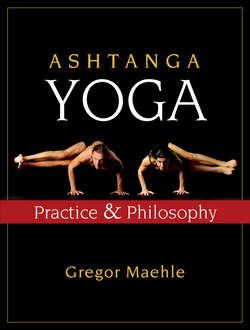Читать книгу Ashtanga Yoga - Gregor Maehle - Страница 20
На сайте Литреса книга снята с продажи.
Vinyasa
ОглавлениеVinyasa Yoga is a system of yoga specifically designed for householders. The difference between a householder (grihasta) and a renunciate (sannyasi) is that the latter has no social duties and can therefore devote ten or more hours per day to practice. In fact, if individual techniques pertaining to all the eight limbs were practiced daily, one would easily spend more than ten hours practicing. For example a wonderful day could be had by practicing asana for two hours, pranayama for two hours, mudra and japa (repetition of mantra) each for one hour, reading of scripture one hour, chanting of scripture one hour, reflection and contemplation one hour, meditation one hour.
A householder — meaning someone who has a family and a job or a business to attend to — can never spend so much time on the practice. The idea of completely turning your back on society is actually fairly recent, relatively speaking. It was introduced by Gautama Buddha and elaborated on by Shankara. The ancient vedic and upanishadic rishis, although they spent considerable time in the forest, were not dropouts. Rishis like Yajnavalkya, Vasishta, and Vishvamitra had wives and children, and held positions such as priest or royal counselor.
For a yoga practice to work for householders, it would be necessary to compress it into two hours and yet retain its benefits, and so the eight limbs would have to be practiced simultaneously and not sequentially. With this in mind Rishi Vamana created the Vinyasa Yoga. The rishi arranged the practice in sequences, such that the postures were potentiating their effects, and combined them with mudra, pranayama, and meditation so that a ten-hour practice could be effectively compressed into two hours.
One of Vinyasa Yoga’s outstanding features is that postures are not held for a long time. One of the greatest traps in physical yoga is to get identified with postures and preoccupied with the body. One thinks, “Now I am sitting in Padmasana. This is yoga!” One couldn’t be more wrong. To perceive the awareness that witnesses sitting in Padmasana — that is yoga.
The core idea of Vinyasa Yoga is to shift emphasis from posture to breath and therefore to realize that postures, like all forms, are impermanent. The formed — asanas, bodies of life-forms, structures, nations, planets, and so on — come and go. The quest of yoga is for the formless (consciousness) — for what was here before form arose and what will be here after form has subsided. For this reason it was necessary to organize the practice in such a way that nothing impermanent is held on to. Vinyasa Yoga is a meditation on impermanence.
The only thing permanent in the practice is the constant focus on the breath. According to the Brahma Sutra,14 “ata eva pranah” — the breath verily is Brahman. The breath is here identified as a metaphor for Brahman (that is, deep reality, ultimate reality, infinite consciousness). This assertion is based on the authority of the Chandogya Upanishad, where the question is asked: Which is that divinity?15 Answer: “Breath . . . Verily, indeed all beings enter (into life) with breath and depart (from life) with breath.”16 Through vinyasa the postures are linked to form a mala. A mala is commonly used to count mantras during mantra meditation, whereas in Vinyasa Yoga every asana becomes a bead on this mala of yoga postures. In this way the practice becomes a movement meditation.
The practice produces heat, which is needed to burn toxins. Not only physical toxins are meant here, but also the poison of ignorance and delusion. The full-vinyasa practice, which entails coming back to standing between postures, has a flushing effect through the constant forward bending. It can be recommended in cases of strong, persistent toxicity and for recuperation after disease. The half-vinyasa practice, in which one jumps back between performance of the right and left sides of sitting postures, is designed to create a balance between strength and flexibility and to increase heat.
If asana only is practiced, this might lead to excess flexibility, which can destabilize the body. The proper position of the bones in the body, and especially of the spine, is remembered by sustaining a certain core tension in the muscles. If the tension is insufficient, frequent visits to a chiropractor or osteopath may become necessary.
In the vinyasa method, this possibility is avoided by jumping back between sides, which gives us the strength to support the amount of flexibility that is gained. This concept is important to understand. Flexibility that cannot be supported by strength should not be aimed for.
The underlying principle here is that of simultaneous expansion into opposing directions. Whenever we expand into one direction, we at the same time need to counteract that by expanding into the opposite direction. In this way we are not caught into extremes of body and mind. Patanjali says, “Thus one is unassailed by the pair of opposites.”17 For this reason one needs to place the same importance on vinyasa as on asana. As Rishi Vamana put it, “Oh Yogi, don’t practice asana without vinyasa.”
